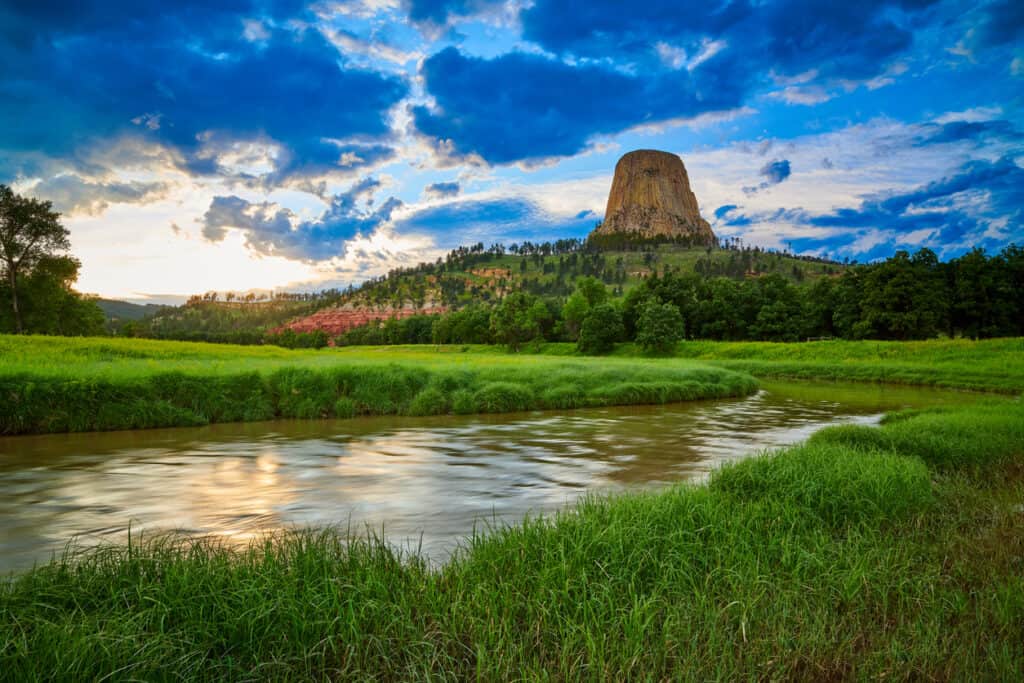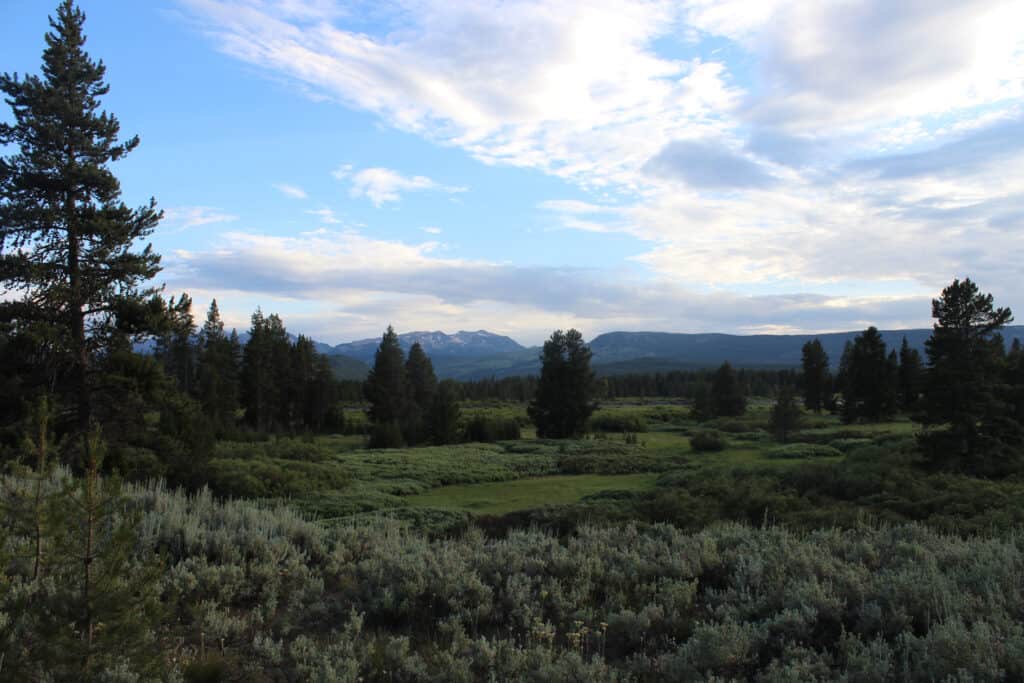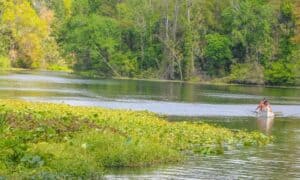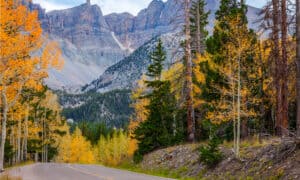Wyoming is a state in the mountain west subregion of the Western United States and is home to seven famous natural park service sites. With breathtaking landscapes, wide rivers, iconic landscapes, fossils, and beautiful scenery, these national parks are rich in natural wonders and old western history that draw visitors worldwide.
In 2015, these national parks managed by the National Park Service received more than 7 million visitors, which ultimately led to an economic boost equivalent to $1.1 billion. Here are the seven parks in Wyoming.
1. Bighorn Canyon National Recreation Area

Bighorn Canyon offers a diversity of wildlife ranging from native bison, bighorn sheep, wild horses, and many bird and reptile species.
©iStock.com/zrfphoto
| Bighorn Canyon National Recreation Area | |
|---|---|
| Size | Approximately 120,000 acres |
| Animals to see | Native bison, bighorn sheep, elk, wild horses, coyotes, mountain lions |
| Attraction to see | Bighorn Canyon, bighorn lakes |
The recreational area of approximately 120,000 acres between Montana and Wyoming was established in 1966 to conserve the area’s natural and cultural resources and provide for multiple recreational opportunities. It features 1,000 to 2,500 feet high vertical cliffs carved by the river. The park is host to a bighorn canyon, bighorn lakes, mountains, upland prairie, towering sheer cliffs, and other great views. Paleo-Indians first inhabited the park area, which was used for thousands of years until the Crow finally made it their home.
According to the Wildlife Society Bulletin, Bighorn Canyon offers a diversity of wildlife ranging from native bison, bighorn sheep, elk, wild horses, coyotes, mountain lions, birds, and more than 200 species of birds and reptiles. Visitors enjoy hiking, cycling, camping, fishing, and wildlife watching.
2. Devils Tower National Monument

Devils Tower National Monument covers 1,346 acres of land.
©iStock.com/Patrick Jennings
| Devils Tower National Monument | |
|---|---|
| Size | 1,346 acres |
| Animals to see | Deer, foxes, prairie dogs, prairie falcons |
| Attraction to see | Devil’s Tower |
Devils Tower, located in northeastern Wyoming, was established in 1906 and was declared America’s first national monument by former President Theodore Roosevelt based on its historical significance. With an area of 1,346 acres, it’s known as a famous natural wonder and a holy place for Native Americans. Rising about 1,267 feet above the surrounding terrain and standing at 867 feet from summit to base, the site is an igneous intrusion in Northern Wyoming.
Prairie Dog Town’s antics will keep you entertained if you appreciate viewing wildlife. These little rodents live in tunnels beneath the surface of the ground in towns. Deer and foxes can also be found, and peregrine and prairie falcons. It’s a good idea to bring your binoculars and camera, as you never know what surprises may come your way.
In June, it is a site for various indigenous religious activities. The site gained the limelight in Hollywood and was featured in the movies Close Encounters of the Third Kind and Transformers: Revenge of the Fallen.
3. Fort Laramie National Historic Site

Fort Laramie National Historic Site is located in southeastern Wyoming, approximately 90 miles from Cheyenne.
©iStock.com/rozdemir01
| Fort Laramie National Historic Site | |
|---|---|
| Size | 833 acres |
| Animal to see | Bats |
| Attraction to see | Fort Laramie Historical Association Bookstore |
Fort Laramie was Wyoming’s first permanent settlement. It was originally known as Fort William until it was renamed Fort John. It served as a significant trading post during the 19th century. Fort Laramie, the military post, was first founded in 1849 when the army bought Old Fort John for $4,000 and began building a military outpost to maintain security along the Oregon Trail.
The site is located in southeastern Wyoming, approximately 90 miles from Cheyenne, and covers 833 acres of land. It was a diplomatic site within the confluence of two rivers, the Laramie and the North Platte River, and it also served as host to Sioux Chiefs and delegates from the USA.
An 18-minute film about the fort’s history and its significance can be viewed at the visitors’ center. There are also uniforms, weaponry, and artifacts from the western frontier’s history on display. You should also visit the Fort Laramie Historical Association Bookstore. There are so many books and so little time.
The Confluence Trail allows you to learn about both history and the environment. This is a 1.6-mile loop that starts from the Old Army Bridge to the North Platte and Laramie Rivers’ confluence.
4. Grand Teton National Park

Grand Teton National Park is one of the ten most visited national parks in the United States.
©anthony heflin/Shutterstock.com
| Grand Teton National Park | |
|---|---|
| Size | 310,000 acres |
| Animals to see | Moose, bison, black bears, elk, grizzly bears |
| Attraction to see | Snake River overlook, Schwabacher landing |
Grand Teton National Park is located in northwestern Wyoming in Teton County, the United States, and was first established in 1929. The park measures 310,000 acres in land area and offers a scenic mountain haven for recreation enthusiasts. It was initially two separate parks: Grand Teton and Jackson Hole National Monument, before they were combined in 1950 into the existing park in use today.
Grand Teton National Park is one of the ten most visited national parks in the United States and is considered a photographer’s paradise, a place of magical sunrises, abundant wildlife, and breathtaking hikes. It is a designation for recreational activities such as hiking, fishing, and camping. The site is inhabited by different wildlife species, including birds, fish, and vascular plants, so make sure you come along with your camera.
5. Yellowstone National Park

Yellowstone National Park is a refuge for outdoor enthusiasts and America’s native animals, like the mighty bison.
©Lillac/Shutterstock.com
| Yellowstone National Park | |
|---|---|
| Size | 2,219,791 acres |
| Animals to see | Bison, moose, badgers, deers, otters, wolves |
| Attraction to see | Old Faithful, Yellowstone Lake, Upper Geyser Basin |
With a fire in its heart, Yellowstone is a melting pot of savage beauty, created by one of the biggest explosions ever to rock the earth. More than anywhere in the world, its violent heart still smolders, blowing off steam through some 300 geysers. The most famous geyser, Old Faithful, hurls hot water 150 feet into the air every 60 to 90 minutes.
Yellowstone National Park stretches across the northwest corner of Wyoming, reaching into Idaho and Montana. It was established in 1872, became the world’s first national park, and is now host to over 4 million adventures per year. This site is the very best of the American wilderness wrapped up into a 2.2 million-acre gift for nature lovers.
Abounding with lovely views, the park is a refuge for outdoor enthusiasts and America’s native animals, like the mighty bison. There is a long list of activities you can engage in, including fishing, camping, hiking, rafting, and sightseeing.
6. Fossil Butte National Monument

Fossil Butte National Monument covers 8,198 acres of land.
©iStock.com/snikeltrut
| Fossil Butte National Monument | |
|---|---|
| Size | 8,198 acres |
| Animals to see | Squirrels, chipmunks, jackrabbits, mule deer |
| Attraction to see | Eocene Green River formation, Fossil Lake |
Fossil Butte National Monument is located in Southwest Wyoming, 15 miles west of Kemmerer, Wyoming, and it is home to more fish fossils than anywhere else in the world. It is not only the preservation of fossils that is important but also the diversity and abundance of fossils. Diversity includes all sorts of different types of fish, reptiles, and crocodiles.
The visitor center houses a collection of fossil fishes, plants, birds, reptiles, insects, and mammals from the old Fossil Lake. It’s a fantastic opportunity to study the history of long-dead creatures. This high desert oasis’s wildlife, vegetation, and geology are all represented in wayside exhibits. Sit on the benches overlooking Fossil Butte at the summit and take in the breathtaking views.
Fossils preserved within the Eocene Green River formation include fish, alligators, bats, turtles, dogs, horses, insects, and many other variants of plants and animals.
7. John D. Rockefeller Memorial Parkway

John D. Rockefeller Memorial Parkway is home to black bears, moose, elk, bighorn, and Yellowstone grizzly bears.
©iStock.com/Tim_Lescinski
| John D. Rockefeller Memorial Parkway | |
|---|---|
| Size | 24,000 acres |
| Animals to see | Black bears, moose, elk, bighorn, and Yellowstone grizzly bears |
| Attraction to see | Yellowstone National Park, Grand Teton National Park |
John D. Rockefeller Memorial Parkway is a scenic, paved road that connects two parks: Grand Teton National Park and Yellowstone National Park in Wyoming. The park was named in remembrance of John D. Rockefeller Jr., a philanthropist and a conservationist who played an important role in creating and preserving numerous parks. The park covers 24,000 acres and was created in 1972 through the authorization of the United States Congress. It is referred to as a transitional zone and is a vital part of the Yellowstone ecosystem.
The site offers wildlife viewing opportunities and bridges the gap between scenic drives and outdoor activities. Wildlife such as black bears, moose, elk, bighorn, and Yellowstone grizzly bears are found there. Activities include horseback riding, scenic float trips, and snowmobiling tours.
The photo featured at the top of this post is © iStock.com/SL_Photography
Thank you for reading! Have some feedback for us? Contact the AZ Animals editorial team.






